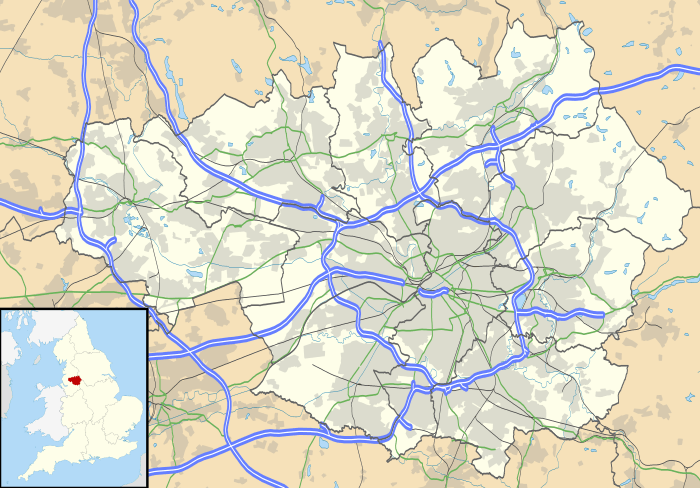Harwood, Greater Manchester
Harwood is a suburb to the north-northeast of Bolton, Greater Manchester, bordering Bury in North West England. Harwood is also part of the historic county of Lancashire.
History
The township was recorded as Harewode in 1212 and 1302. The manor which included Bradshaw, was part of the Manchester fee held by the Grelleys in the Middle Ages. In 1212 it was divided, the parts held by Roger de Samlesbury and Alexander de Harwood. The Samlesbury portion descended in the same way as Breightmet and the Harwood portion to the Traffords of Trafford who sold it in 1589 and afterwards much divided. The Radcliffes and Bartons of Smithills Hall held land in Harwood for many generations and Adam Mort of Astley held a messuage and a fulling mill in 1630. [1] In 1612, Sir Nicholas Mosley and his son, Edward, conveyed the manor of Harwood to a partnership of five yeomen; Matthew Harrison, Henry Haworth, Raufe Higson, Lawrence Horrocks and Edward Greenhalgh.[2] In the Hearth tax returns of 1666, forty-two hearths were liable to tax but only one house had three hearths. The common lands were enclosed in 1801. Christ Church was built in 1840 and Wesleyan and Primitive Methodist chapels were also built. [1]
Governance
Lying within the boundaries of the historic county of Lancashire since the early 12th century, Harwood was a township in the ecclesiastical parish of Bolton le Moors in the Hundred of Salford.[3] In 1837 it became part of the Bolton Poor Law Union which took responsibility for funding the Poor Law in that area[4] and in 1898 it became part of Turton Urban District.[5]
Geography
Harwood is 2½ miles north east of Bolton in the West Pennine Moors to the north of the road to Bury. Bradshaw Brook separates it from Tonge. The township covered about 1,240 acres (5.0 km2) of hilly land, the highest point is 825 feet (251 m) at Bowstone Hill and the lowest 300 feet (91 m). Stone was quarried and the brooks used by bleachworks. The underlying rocks are coal measures, sandstones and shales.[1][3]
Originally a small village within the former Turton Urban District, but now a small part of the Metropolitan Borough of Bolton. Harwood is mostly residential, with the few businesses concentrated around a Morrisons supermarket at its centre. Neighbouring districts include Affetside, Bradshaw and Breightmet.
Harwood has several public houses; (the House Without a Name, the Seven Stars, the Grey Mare, the Old School House and the White Horse) two restaurants, a doctors' surgery and a cruising park (Longsight Park, though there is a small recreational ground for children off Recreation Street).
Transport
Harwood is served by the 507 bus from Bolton. On Monday to Saturday weekdays, the 480 runs hourly running between Bolton and Bury, via Bradshaw, Harwood, Affetside and Tottington. The nearest railway stations are located at Hall i' th' Wood within walking distance on the main road and Bromley Cross within the public footpaths in Bradshaw.
Education
Primary schools in the area are St Brendan's, St Maxentius, Harwood Meadows, Hardy Mill and the now-closed Longsight and Christ's Church. The popular secondary school for residents of Harwood is Turton High School in Bromley Cross, though both Canon Slade and Bolton St Catherine's Academy are nearby.
See also
References
- Farrer, William; Brownbill, J., eds. (1911), "Harwood", A History of the County of Lancaster: Volume 5, British History Online, pp. 268–270, retrieved 27 November 2010
- Horrdige, J. F. (2006). Harwood: The Early Years. Turton Local History Society. pp. 27–28.
- Lewis, Samuel (1848), "Harwood", A Topographical Dictionary of England, British History Online, pp. 431–435, retrieved 27 November 2010
- Workhouse, workhouses.org.uk, archived from the original on 5 June 2011, retrieved 28 November 2010
- Greater Manchester Gazetteer, Greater Manchester County Record Office, Places names - G-H, archived from the original on 18 July 2011, retrieved 27 November 2010
